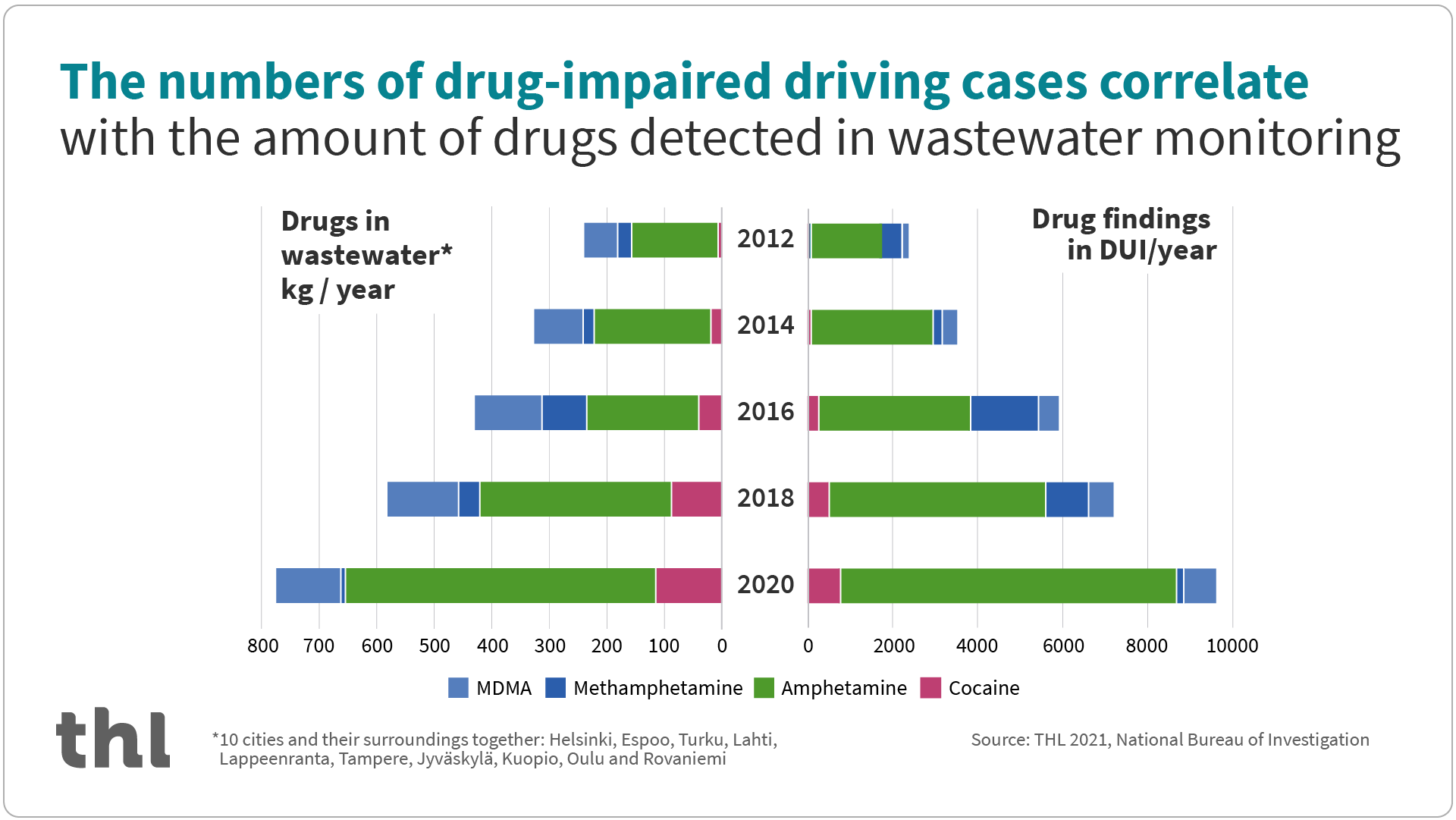Results of THL’s wastewater study: Amphetamine use in Finland continues to grow – use of cocaine has now levelled out
THL's wastewater studies show that the use of amphetamine has continued to increase in Finland. At the same time, the growth in the use of cocaine has stabilised and the use of ecstasy has decreased. The numbers of drug-impaired driving cases correlate with the amount of drugs detected in wastewater monitoring.
The latest results of the extensive national wastewater drug-content monitoring have come from sampling carried out in 27 cities and their surrounding areas in November and December last year and from sampling carried out in March of this year in Helsinki, Espoo, Turku and Tampere. Last year, drug use was examined in March, May–June, August and November–December. Four of the cities in the previous study were included for the first time. The population base of the study covers approximately 60 % of the Finnish population.
The results indicate that amphetamine is widely used throughout the country and its use has continued to grow, especially in the Helsinki Metropolitan Area. In March 2021, the highest levels of amphetamine use ever recorded were found in Helsinki and the neighbouring regions. In addition to Helsinki, the wastewater treatment plant in Viikinmäki in Helsinki also covers central and eastern parts of Vantaa and Tuusula, Sipoo, Järvenpää, Kerava, Mäntsälä and Pornainen.
In addition to the Helsinki Metropolitan Area, an upward trend in the use of amphetamine was also observed in Lappeenranta, Kotka and Pori.
- Monitoring at 27 wastewater plants (pdf, 24 KB, in Finnish)
‘The strong growth in the use of amphetamine at the population level is also reflected in societal side effects such as increased drug-impaired drunken driving,’ says Head of Unit Teemu Gunnar from the Finnish Institute for Health and Welfare.

Reduced use of ecstasy – use of alpha-PVP centred on the capital region
The strong growth in the use of cocaine has stabilised over the last couple of years, and several cities have seen a slight decrease from the peak figures reached last year. This development can be seen especially in the Helsinki Metropolitan Area and in the largest cities.
The use of cocaine is nevertheless many times higher than it was in 2012. Cocaine use continues to be more and more centred around the Helsinki Metropolitan Area, as shown also by previous studies. North of Tampere, use of cocaine in Finland is very low and sporadic.
Ecstasy is used everywhere in Finland, but its use has also decreased in many of the cities examined.
‘Cocaine use has stabilised and ecstasy use has even decreased during the coronavirus restrictions in many of the cities studied. This may have been influenced not only by the availability of drugs but also by restrictions on gatherings and night-life,’ explains Development Manager Aino Kankaanpää.
Methamphetamine use is currently very low in Finland. The use of methamphetamine has fallen considerably since 2016 and 2017, when it temporarily exceeded even the use of amphetamine in the Helsinki Metropolitan Area.
In Finland, the most common new drug associated with problem use, alpha-PVP, was regularly detected only in the Helsinki Metropolitan Area and its vicinity, at the Nummela treatment plant in Vihti. Regional and temporal fluctuations in the use are clearly higher for designer drugs than for traditional drugs.
Long-term monitoring shows regional differences in the development of the drug situation
Monitoring carried out over many years shows that there are regional differences in the development of the drug situation in Finland. For example, the combined use of amphetamine, cocaine, ecstasy and methamphetamine in the Helsinki Metropolitan Area and neighbouring regions is now many times higher than it was when the monitoring began in 2012. During the same period, the growth in drug use in the regions of Turku and Lahti has been lower.
In Vaasa and Joensuu, meanwhile, drug use volumes have fallen back to nearly the same level as previous years, following the temporary increase in drug use observed in spring last year.
‘At the national level, the combined use of amphetamine, cocaine, ecstasy and methamphetamine is approximately three times higher than in 2012, when a comprehensive national wastewater survey was carried out for the first time,’ Gunnar summarises.
Amphetamine is still used more in Finland than in the rest of Europe, while cocaine is used significantly less
In spring 2020, amphetamine was still used more in Finland than in many other European countries. The use of cocaine in Finland, on the other hand, remained significantly lower than the European average, despite the fact that the use of the substance has increased over the long term, especially in the Helsinki Metropolitan Area.
An international wastewater survey published annually by the European Monitoring Centre for Drugs and Drug Addiction (EMCDDA) compares the results of samples collected in the spring over the course of a week. In 2020, 99 cities from 27 different countries participated in the study. The population base for the study totalled around 50 million people. Finland reported the results of all 27 cities examined.
The Finnish Institute for Health and Welfare is responsible for reporting the Finnish figures for use in international comparisons. EMCDDA will publish the results on the 18th of May.
Further information:
Wastewater study website (in Finnish)
Teemu Gunnar
Head of Unit
tel. +358 (0)29 524 8425
[email protected]
Aino Kankaanpää
Development Manager
tel. +358 (0)29 524 8427
[email protected]



